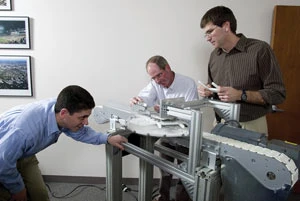
The emergence of combination products is changing the medical device landscape. Defined as two or more regulated components - drugs, medical devices or biologics - combined through physical or chemical means, combination products inherently require two separate skill sets for development. Medical device companies used to possess 100% of the expertise needed to develop a product, but they must now share product development ownership with a biotech/pharmaceutical partner. The shared development model intensifies every aspect of product development from IP and regulatory issues, to packaging and marketing strategy. For these and many other reasons, it is critical that products are well-targeted.
With countless combinations of device, pharmaceutical drug and/or biologic, the opportunities in this market are exponential. However, in order to be successful, a product must not only satisfy a real market need, but it must also be uniquely different from anything the competition has to offer.
DEMAND, DEVELOPMENT
Accurately assessing market demand is the first step toward developing a successful product. As with the entire product development process, medical device companies can benefit from using an external design engineering firm to conduct market research. Objectivity is a central ingredient in research and with no financial stake in the technology or device, an external engineering firm fits this profile.
More than just identifying market needs, combination product makers must consider the accessibility of the product to its target audience.
For example, if a product is targeted for Type 2 diabetes, then product developers should consider the elderly population a primary market, and make obtaining national coverage and reimbursement from the Centers for Medicare and Medicaid Services (CMS) a top priority.
Since CMS will require evidence that the combination product will provide a clinically more effective therapy than is currently offered, combination product makers should identify clear differentiators at product concept. Similarly, CMS wants companies to demonstrate that the combination product will provide a significant health benefit. Product developers should, therefore, have some way of measuring the health benefits of their products.
CHALLENGES
As two separate regulated components, combination products present unique manufacturing challenges. Beyond the physical design challenges of combining the two entities, sterilization, validation and drug/device interaction issues further complicate the development process. In addition, if chemicals known as extractables and leachables migrate from plastic medical device components, drug products can become contaminated.
Since traditional device sterilization procedures, such as ethylene oxide gas (EtO), can render drugs ineffective, new strategies may need to be developed to ensure product sterility, especially for biological drugs.
Primary Mode of Action (PMOA) is defined as the single mode of action of a combination product that provides the most important therapeutic result.
While each combination product has a PMOA that determines its assignment to one of three FDA regulatory centers for review, the process of defining the PMOA can be complicated in and of itself. To minimize regulatory confusion, it is best to establish an intended PMOA at the outset of the project. Of the three agencies to which a product can be submitted - the Center for Biologics Evaluation and Research (CBER), the Center for Drug Evaluation and Research (CDER), or the Center for Devices and Radiological Health (CDRH) - the CDRH is often considered the shortest and clearest route to regulatory approval. Given the differences in scale, timeliness and other matters, device and pharmaceutical companies may not always agree on PMOA. It is therefore beneficial to consult with experts, including regulatory counsel.
Regardless of whether the product is a combination device, traditional medical product, or an innovation in an altogether different market, planning for manufacturing should begin as soon as a product concept is developed.
This will avoid developing a product that is extremely difficult to manufacture. It will also enable the company to determine whether standard equipment, a modified version of it, or a unique proprietary system will be required for manufacturing. For example, discovering that a product cannot be manufactured on standard equipment once the prototype has been finalized comes at a stage in the process when changes will be costly and time-consuming.
Just as an external engineering partner can recommend standard manufacturing equipment and customize proprietary solutions, it can also help medical device companies select a manufacturing partner to produce the product. Selection of manufacturing partners will depend largely on the technology planned for use in the device and the materials from which it will be constructed. In the case of combination products, more than one manufacturing partner is often required due to the complexity of the product.
CONCLUSION
Medical device and pharmaceutical companies have a unique opportunity to establish themselves as leaders in the burgeoning combination products market. With the exception of medical and pharmaceutical giants like Johnson & Johnson, in many cases the most successful companies are not necessarily the most innovative, but rather the ones that are best at partnering and collaborating. This is because in the world of combination products, a medical device is only as innovative as its other half - the pharmaceutical component.
Outsourcing can help bridge the gap between the pharmaceutical and medical device industries by fostering collaboration and innovation among companies that often do not see eyeto- eye. External engineering firms possess the multidisciplinary expertise needed to understand both sides of the combination product equation, and can fill the knowledge gaps while ensuring IP protection.
Foster-Miller Inc., a QinetiQ company
Waltham, MA
foster-miller.com

Explore the July 2009 Issue
Check out more from this issue and find your next story to read.
Latest from Today's Medical Developments
- Arcline to sell Medical Manufacturing Technologies to Perimeter Solutions
- Decline in German machine tool orders bottoming out
- Analysis, trends, and forecasts for the future of additive manufacturing
- BlueForge Alliance Webinar Series Part III: Integrate Nationally, Catalyze Locally
- Robot orders accelerate in Q3
- Pro Shrink TubeChiller makes shrink-fit tool holding safer, easier
- Revolutionizing biocompatibility: The role of amnion in next-generation medical devices
- #56 Lunch + Learn Podcast with Techman Robot + AMET Inc.





